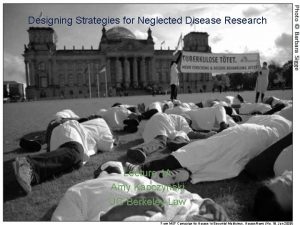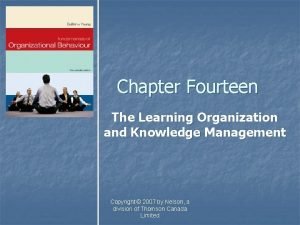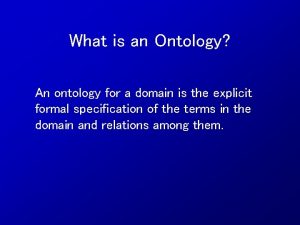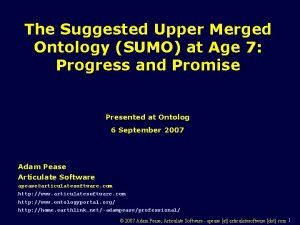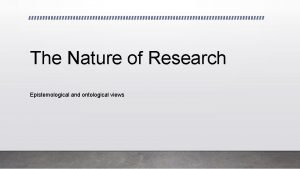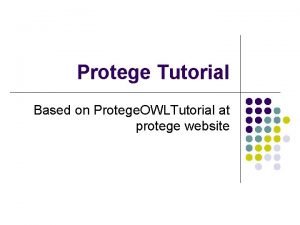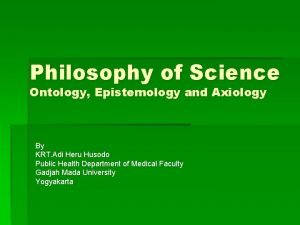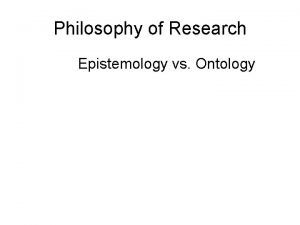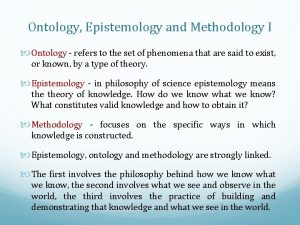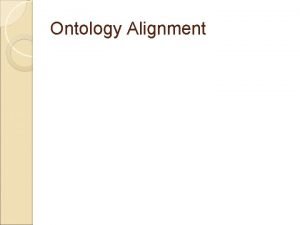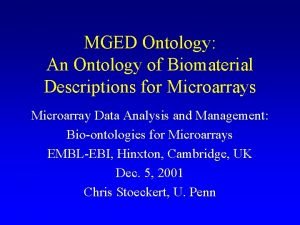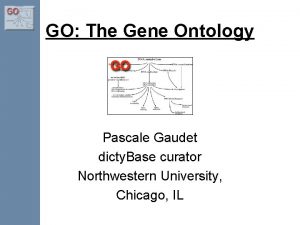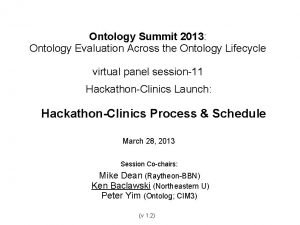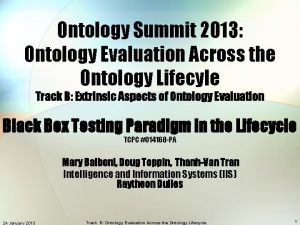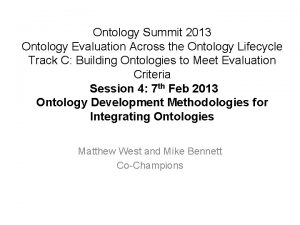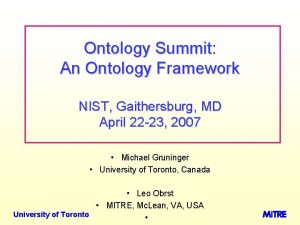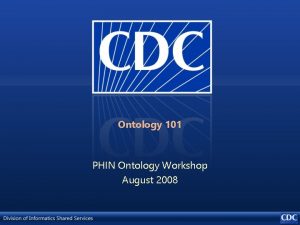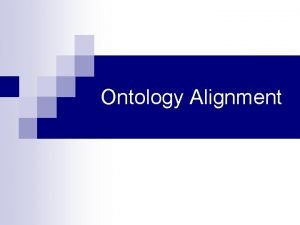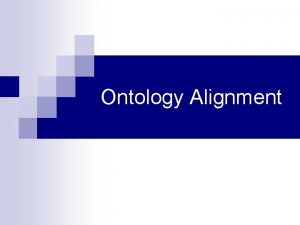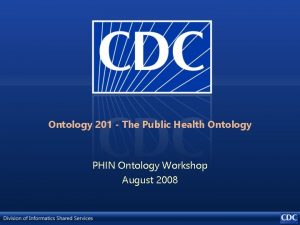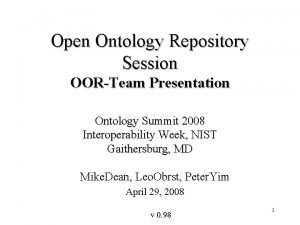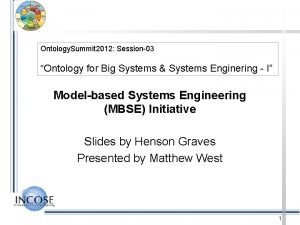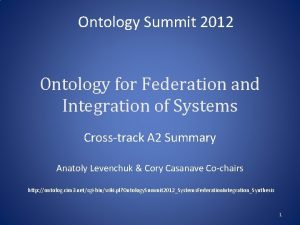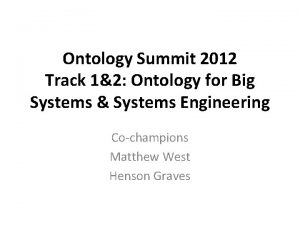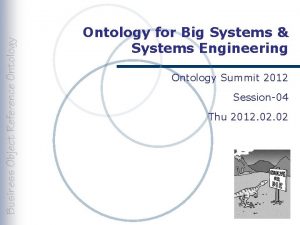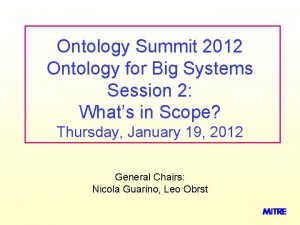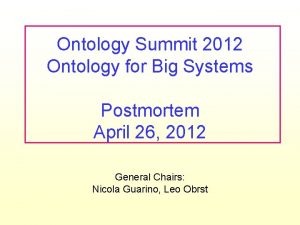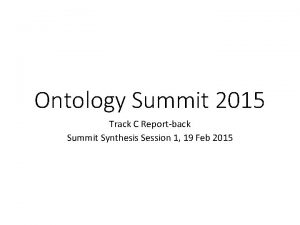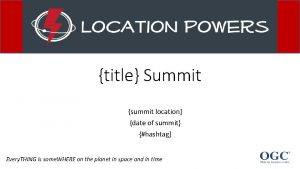Ontology Framework Results of Ontology Summit 2007 Michael


















- Slides: 18

Ontology Framework: Results of Ontology Summit 2007 Michael Gruninger University of Toronto 1

Ontology Summit 2007 • This is based on the proceedings and communique from the 2007 Ontology Summit. Entitled: “Ontology, Taxonomy, Folksonomy: Understanding the Distinctions, ” that initiative took place virtually on the Ontolog Forum between January and April of 2007 and culminated in 2 -day workshop (April 22 -23, 2007) in Gaithersburg, Maryland, US, at the National Institute of Standards and Technology (NIST). • Contributors: – members of the wider ontology community • Refer to details at: – http: //ontolog. cim 3. net/cgi-bin/wiki. pl? Ontology. Summit 2007 2

Challenge • Ontologies were originally proposed to enable sharable and reusable representations of knowledge. • Nevertheless, the sheer range of current work in ontologies (including taxonomies, thesauri, topic maps, conceptual models, and formal ontologies specified in various logical languages) raises the possibility of ontologies being developed without a common understanding of their definition, implementation and applications. 3

Objective • Provide a framework that ensures that we can support diversity without divergence, so that we can maintain sharability and reusability among the different approaches to ontologies. • To this end, we can define a set of characteristics common to all approaches and then propose a set of features that can be used to distinguish among different approaches. 4

What we have in common • An ontology includes a vocabulary together with a specification of the meanings of the terms in the vocabulary. • This specification includes: – identification of the fundamental categories in the domain – identification of the ways in which members of the categories are related to each other – constraining the ways in which the relationships can be used. 5

Dimensions • We can identify a set of dimensions that can be used to distinguish among different approaches to ontologies. • There are two kinds of dimensions: • Semantic - how an ontology specifies the meaning of its vocabulary • Pragmatic - the purpose and context in which the ontology is designed and used 6

Semantic Dimensions • Expressiveness of the ontology representation language • Level of structure • Representational granularity 7

Ontology Representation Languages • Ontologies differ in the languages used in their specification. • The oft-cited “semantic spectrum”is a comparison of languages rather than ontologies themselves. • There are two distinctions here – model theory – expressiveness 8

Model Theory • Logical languages have both a formal syntax and a model-theoretic semantics – e. g. RDF, OWL, and Common Logic • Semiformal languages, have a formal syntax but lack a model-theoretic semantics. – e. g. XML and EXPRESS • Numerous ontologies whose terms and definitions are specified only in natural language 9

Expressiveness • One representation is as expressive as another if it can encode all the meanings of the other language. • Expressiveness gives a partial order on languages, because some languages might encode some of the statements of one language but not others. • Ontologies themselves can be compared with respect to the languages with the minimal expressiveness required to define their vocabularies. 10

Level of Structure • We can characterize an ontology with respect to the extent to which the intended interpretations of the vocabulary are defined in a logical language. • In a structured ontology, the intended interpretations for all terms in the vocabulary are defined by sentences in a logical language. • In a semi-structured ontology, the intended interpretations of some terms in the vocabulary are captured in a semiformal language. – Semistructured ontologies require extralogical conditions or special implementations to specify the intended interpretations of some of the terms in their vocabularies. • Finally, the intended interpretations of all terms in the vocabulary of an unstructured ontology are represented in a semiformal or informal language. 11

Representational Grranularity • An ontology with coarse granularity is specified using only very general representational primitives, such as concepts and subsumption in a taxonomy • An ontology fine granularity specifies much more detail about the properties of concepts and how they can relate to each other. • This characterization is independent of the ontology representation language 12

Pragmatic Dimensions • • • Intended use Role of automated reasoning Descriptive vs prescriptive Design methodology Governance 13

Intended Use • Ontologies are typically designed with respect to some intended application, which include – – – sharing knowledge bases; enabling communication among software agents; integration of disparate data sets; representation of a natural language vocabulary; help provide knowledge-enhanced search; 14

Automated Reasoning • We can to characterize ontologies by the kinds of automated reasoning supported in software applications that use the ontology – Simple – Special – General 15

Descriptive vs Prescriptive • In descriptive approaches, the content of the ontology describes the intended interpretations by characterizing the entities and the relations among entities as a user or an expert might characterize those objects. • In prescriptive approaches, the content prescribes the intended interpretations by explicitly mandating the way that those entities and their relationships are characterized. 16

Design Methodology • Methodologies vary from a strong software engineering design lifecycle with requirements, evaluation, and verification, all the way to a "nodesign" methodology in which folksonomies emerge from the local behavior of thousands of individual users. 17

Applications • An important application of the ontology framework will be to serve as the basis for specifying metadata for different ontologies, which will include the properties and characteristics do we use to describe an ontology. • This will allow different ontologies to be compared, particularly when they are developed using different approaches. • Ultimately, the ontology metadata can be used to characterize the conditions under which ontologies can be shared and reused. 18
 Who building blocks framework 2007
Who building blocks framework 2007 Who building blocks framework 2007
Who building blocks framework 2007 Eu results framework
Eu results framework Dispositional framework vs regulatory framework
Dispositional framework vs regulatory framework What is theoretical framework
What is theoretical framework Example of conceptual framework in accounting
Example of conceptual framework in accounting Theoretical framework
Theoretical framework Dispositional framework vs regulatory framework
Dispositional framework vs regulatory framework Theoretical framework
Theoretical framework What is an ontologist
What is an ontologist Suggested upper merged ontology
Suggested upper merged ontology Ontological vs epistemological
Ontological vs epistemological Pizza ontology tutorial
Pizza ontology tutorial Ontology epistemology axiology
Ontology epistemology axiology Research ontology and epistemology
Research ontology and epistemology Ontology refers to
Ontology refers to Ontology alignment
Ontology alignment Types of ontology
Types of ontology What is meant by gene ontology?
What is meant by gene ontology?
